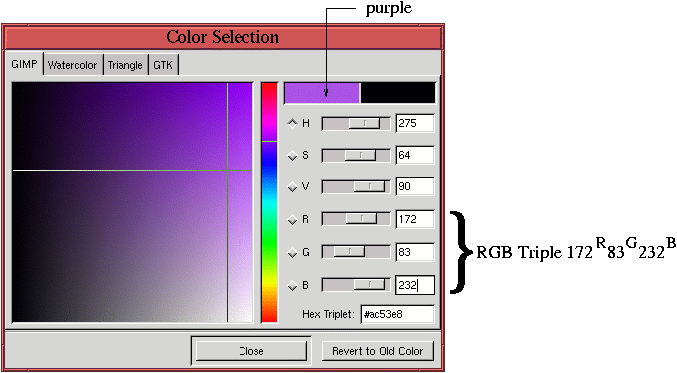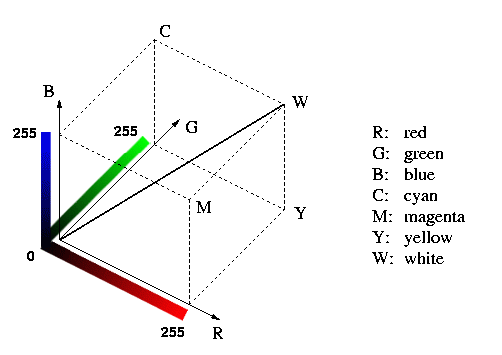5.1 The RGB Colorspace
The RGB colorspace is important to us because it is what we see when
we look at a color monitor. The monitor mixes together different
amounts of red, green, and blue primaries. Because of this, the
colors that can be seen on a computer monitor can be represented as
triples of numbers or as vectors in a three-dimensional
cube. The amount of each primary contained in
a color can be represented by a number in a fixed range. Because the
GIMP uses 8 bits per primary color channel, the range per primary is 0
to 255 (28=256). Here, 0 means no primary is used and 255 means
that there is as much primary as the monitor can produce. Although
there are issues with white balance, calibration, and human visual
perception, it is presumed that the three primaries combined at full
strength produce white and the three combined at zero strength produce
black. Of course, the black produced is no deeper than that of the
monitor when turned off.
When it is useful to talk about colors in numeric terms, as it is in
Chapter
6, which discusses color correction, we will
use a special notation to designate colors. For example, the purple
composed of a red at 172, a green at 83, and a blue at 232 will be
denoted
172R 83G 232B. This color is
illustrated in Figure
5.1,
Figure 5.1:
Representing a Color with an RGB Triple: Purple=
172R 83G
232B
 |
which shows how the color is composed using the
Color Selection
tool. This tool is opened by clicking on the
Active Foreground Color or
Active Background Color patches
in the toolbox. The tool dialog can be used to display RGB colors.
These are dialed in using the sliders or can be entered numerically.
The selected color appears in a patch at the upper right of the
dialog. What we have here is digital finger paint!
As you will see later in this chapter, it is useful to think of the
triples formed by the primaries as a color cube where each of the
primaries forms one of the principle axes. The RGB color cube is
illustrated in Figure
5.2.
Figure 5.2:
The RGB Color Cube
 |
Each axis of the cube represents values of red, green, or blue in the
range [0,255]. The red axis, labeled R, shows the associated color
scale beneath it. The green and blue axes are illustrated similarly.
As mentioned earlier, 0 means that the monitor does not emit the
primary color and 255 means that it emits the maximum. Values between
0 and 255 yield gradations in the color's intensity.
As the word colorspace implies, colors act like vectors. They can be
combined by addition and subtraction to obtain other colors in the
cube. Thus, the origin of the cube, or
0R 0G 0B, represents the
total absence of color, which is black. The far corner from the
origin is the sum of the highest intensities of red, green, and blue,
or
255R 255G 255B. This produces the color white, which is why
this corner of the cube is labeled W in
Figure
5.2. The other corners of the cube
represent the various primary and secondary colors. We've already
encountered red, green, and blue. The remaining three are cyan,
magenta, and yellow. From the labels in
Figure
5.2, it can be seen that adding 255
red to 255 green makes
255R 255G 0B or yellow, adding 255 red to
255 blue makes
255R 0G 255B or magenta, and adding 255 green to
255 blue makes
0R 255G 255B or cyan.
Note that the main diagonal of the RGB cube is illustrated in
Figure
5.2 as a line drawn between the black
origin at 0 and white at W. This line represents the colors in the
RGB cube that consist of equal amounts of red, green, and blue. All
the points on this line are gray. The closer to the origin, the
darker the gray; the closer to W, the lighter. It is for this
reason that the main diagonal of the RGB cube is referred to as the
neutral axis . Grays are neutral because they prefer no hue; they contain
equal quantities of red, green, and blue.
©2000 Gimp-Savvy.com
